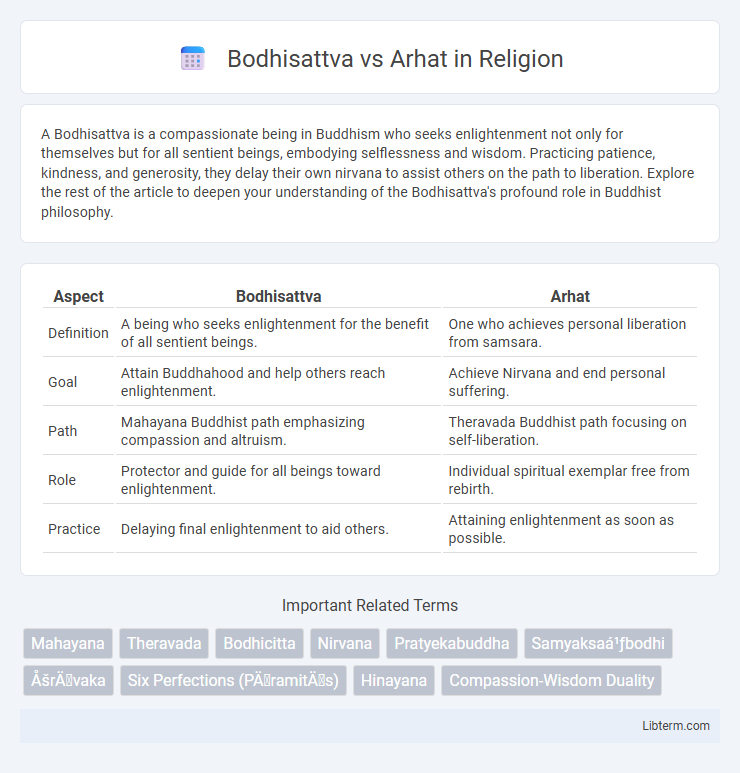A Bodhisattva is a compassionate being in Buddhism who seeks enlightenment not only for themselves but for all sentient beings, embodying selflessness and wisdom. Practicing patience, kindness, and generosity, they delay their own nirvana to assist others on the path to liberation. Explore the rest of the article to deepen your understanding of the Bodhisattva's profound role in Buddhist philosophy.
Table of Comparison
| Aspect | Bodhisattva | Arhat |
|---|---|---|
| Definition | A being who seeks enlightenment for the benefit of all sentient beings. | One who achieves personal liberation from samsara. |
| Goal | Attain Buddhahood and help others reach enlightenment. | Achieve Nirvana and end personal suffering. |
| Path | Mahayana Buddhist path emphasizing compassion and altruism. | Theravada Buddhist path focusing on self-liberation. |
| Role | Protector and guide for all beings toward enlightenment. | Individual spiritual exemplar free from rebirth. |
| Practice | Delaying final enlightenment to aid others. | Attaining enlightenment as soon as possible. |
Introduction to Bodhisattva and Arhat Concepts
The Bodhisattva represents an enlightened being in Mahayana Buddhism who delays final nirvana to help all sentient beings achieve liberation, embodying compassion and selfless service. The Arhat, central to Theravada Buddhism, attains personal enlightenment by overcoming suffering and desires, achieving nirvana primarily for oneself. These contrasting paths highlight the Mahayana emphasis on universal salvation through the Bodhisattva ideal versus the Theravada focus on individual liberation as exemplified by the Arhat.
Historical Context in Buddhism
The Bodhisattva and Arhat represent two distinct historical paths within early Buddhist traditions, with the Bodhisattva ideal emerging prominently in Mahayana Buddhism around the 1st century CE as a compassionate figure who delays nirvana to aid all beings. In contrast, the Arhat figure, central to Theravada Buddhism, epitomizes the early Buddhist goal of individual enlightenment and liberation from the cycle of rebirth. These differing ideals shaped the doctrinal development and practice approaches across Buddhist communities throughout history.
Defining the Arhat Path
The Arhat path in Buddhism represents the ultimate goal of individual enlightenment, where the practitioner attains Nirvana by eradicating personal desires and attachments. Unlike the Bodhisattva path, focused on achieving Buddhahood to liberate all beings, Arhats concentrate on their own liberation from the cycle of birth and death (samsara). This path is characterized by strict adherence to ethical conduct, meditation, and wisdom, leading to the cessation of suffering and the end of karma.
Understanding the Bodhisattva Ideal
The Bodhisattva ideal emphasizes compassion and the commitment to attaining enlightenment for the benefit of all sentient beings, contrasting with the Arhat's pursuit of personal liberation. Central to Mahayana Buddhism, the Bodhisattva embodies selflessness, postponing final nirvana to guide others on the path. This altruistic motivation distinguishes the Bodhisattva ideal as a model of ultimate spiritual dedication within Buddhist practice.
Goals: Personal Liberation vs Universal Compassion
Bodhisattvas aim for universal compassion by postponing their own liberation to help all sentient beings achieve enlightenment, embodying altruistic selflessness in Mahayana Buddhism. Arhats prioritize personal liberation, seeking to attain Nirvana by freeing themselves from the cycle of birth and death, characteristic of Theravada practice. The differing goals highlight Bodhisattvas' collective salvation versus Arhats' individual transcendence in Buddhist philosophy.
Key Differences in Spiritual Practice
The Bodhisattva embraces the Mahayana path, prioritizing universal compassion and the vow to attain enlightenment for the liberation of all beings, often engaging in altruistic practices and the cultivation of paramitas (perfections). The Arhat, central to Theravada Buddhism, focuses on personal liberation by overcoming the cycle of birth and death (samsara) through strict adherence to the Noble Eightfold Path, emphasizing wisdom and detachment. While the Bodhisattva's spiritual practice is expansive and other-oriented, the Arhat's practice is primarily individual and aimed at achieving nirvana for oneself.
Representation in Theravada and Mahayana Traditions
In Theravada Buddhism, the Arhat is revered as the ideal spiritual goal, symbolizing individual enlightenment and liberation from the cycle of rebirth. Mahayana Buddhism emphasizes the Bodhisattva, representing compassion and the commitment to attain Buddhahood for the benefit of all beings, thus delaying personal nirvana. These differing representations reflect Theravada's focus on personal liberation and Mahayana's broader altruistic aspiration toward universal salvation.
Scriptural Sources and Canonical References
Bodhisattvas are extensively detailed in Mahayana scriptures such as the *Lotus Sutra* and the *Avatamsaka Sutra*, where they vow to attain Buddhahood for the liberation of all beings. Arhats are primarily emphasized in Theravada texts like the *Pali Canon*, including the *Digha Nikaya* and *Majjhima Nikaya*, where they achieve personal enlightenment and liberation from samsara. Canonical distinctions highlight the Bodhisattva's path of universal compassion versus the Arhat's focus on individual liberation.
Cultural and Philosophical Impact
The Bodhisattva concept in Mahayana Buddhism emphasizes compassion and the vow to attain enlightenment for the benefit of all beings, profoundly shaping East Asian cultures with ideals of selflessness and altruistic action. The Arhat ideal, central to Theravada Buddhism, underscores individual liberation through rigorous discipline and insight, influencing South and Southeast Asian philosophical traditions emphasizing personal enlightenment. These distinct paradigms have fostered divergent ethical frameworks and ritual practices, deeply embedding themselves in the cultural identities and spiritual narratives of their respective regions.
Contemporary Views and Modern Relevance
Contemporary views often contrast the Bodhisattva's commitment to universal compassion and ongoing enlightenment with the Arhat's focus on individual liberation from suffering. Modern relevance highlights the Bodhisattva ideal in social activism and ethical leadership, inspiring collective well-being and altruism in global contexts. The Arhat concept remains influential in personal spiritual discipline and mindfulness practices, emphasizing inner peace and self-realization.
Bodhisattva Infographic

 libterm.com
libterm.com